engine Citroen C4 DAG 2014.5 2.G Service Manual
[x] Cancel search | Manufacturer: CITROEN, Model Year: 2014.5, Model line: C4 DAG, Model: Citroen C4 DAG 2014.5 2.GPages: 340, PDF Size: 12.89 MB
Page 129 of 340

88
127
C4-2_en_Chap08_securite_ed01-2014
Rear seat belts
The rear seats are each fitted with a three-point
seat belt, with force limiter
and,
for
the
outer
seats,
an
ef
fort
limiter
.
Fastening
F
Pull
the
strap,
then
insert
the
tongue
in
the buckle.
F
Check
that
the
seat
belt
is
fastened
correctly
by pulling the strap.
Unfastening
F
Press
the red button on the buckle.
F
Guide
the seat belt as it reels in.
F
o n the outer seat belts, raise the
bar
to
the
top
of
the
backrest
to
prevent
the
tongue
from
knocking
against
the side trim. This
warning lamp comes on in
the
instrument
panel
when
one
or
more
rear
passengers
unfas
-
ten
their seat belt.
Seat belt unfastened warning lamp
in the instrument panel
3.
Right
hand
rear
seat
belt
warning
lamp.
4.
Centre
rear seat belt warning lamp.
5.
Left
hand
rear
seat
belt
warning
lamp.
Seat belt unfastened warning lamps
display
When
the
ignition
is
switched
on,
with
the
engine
running
or
when
the
ve
-
hicle
is
moving
at
less
than
12
mph
(20
km/h),
the
corresponding
warning
lamps
3
, 4
and
5
come
on
in
red
for
ap
-
proximately
30
seconds,
if
the
seat
belt
is
not fastened.
When
the
vehicle
is
moving
at
more
than 12
mph
(20
km/h),
the
corresponding warning
lamps
3, 4 and
5 come
on
in
red, accompanied
by
an
audible
signal
and
a message
in
the
screen,
if
a
rear
passen
-
ger
has unfastened their seat belt.
From
approximately
12
mph
(20
km/h),
this
warning
lamp
flashes
for
two
minutes accompanied
by
an
audible
signal
of
in
-
creasing
volume.
Once
these
two
minutes have
elapsed,
this
warning
lamp
remains on
until
the
one
or
more
rear
passengers fasten
their seat belt.
SAFETY
Page 135 of 340

99
133
C4-2_en_Chap09_conduite_ed01-2014
A FEW DRIVING RECOMMENDATIONS
Observe the driving regulations at all times
and remain vigilant whatever the
traffic
conditions.
Pay
close
attention
to
the
traffic
and
keep
your
hands
on
the
wheel
so
that
you
are
ready
to
react
at
any
time
to
any
eventuality.
On
a
long
journey
,
a
break
every
two hours
is strongly recommended.
In
difficult
weather
,
drive
smoothly
,
an
-
ticipate
the
need
to
brake
and
increase
the
distance from other vehicles.
Driving on flooded roads
We strongly advise against driving on flooded
roads, as this could cause seri -
ous
damage
to
the
engine
or
gearbox,
as
well
as
to
the
electrical
systems
of
your
vehicle.
Important!
Never drive with the parking brake
applied - Risk of overheat -
ing
and
damage
to
the
braking
system!
Do
not
park
or
run
the
engine when
stationary in areas where
inflammable substances and ma -terials (dry grass, dead leaves...) might
come into contact with the hot
exhaust
system
-
Risk
of
fire!
n
ever leave a vehicle unsuper-
vised
with
the
engine
running.
If
you have to leave your vehicle
with
the
engine
running,
apply
the
parking
brake
and
put
the
gearbox
into
neutral
or
posi
-
tion
N
or P,
depending
on
the
type
of gearbox.
If
you
are
obliged
to
drive
through
water:
-
check
that
the
depth
of
water
does
not
exceed
15
cm,
taking
account
of
waves
that
might
be
generated
by
other users,
-
deactivate
the
Stop
&
Start
system,
-
drive
as
slowly
as
possible
without
stallin
g.
In
all
cases,
do
not
exceed
6
mph
(10
km/h),
-
do
not
stop
and
do
not
switch
of
f
the
engine.
On
leaving
the
flooded
road,
as
soon
as
circumstances
allow
,
make
several
light
brake
applications
to
dry
the
brake
discs
and
pads.
If
in
doubt
on
the
state
of
your
vehicle,
contact
a
CITROËN
dealer
or
a
quali
-
fied
workshop.
DRIVING
Page 136 of 340
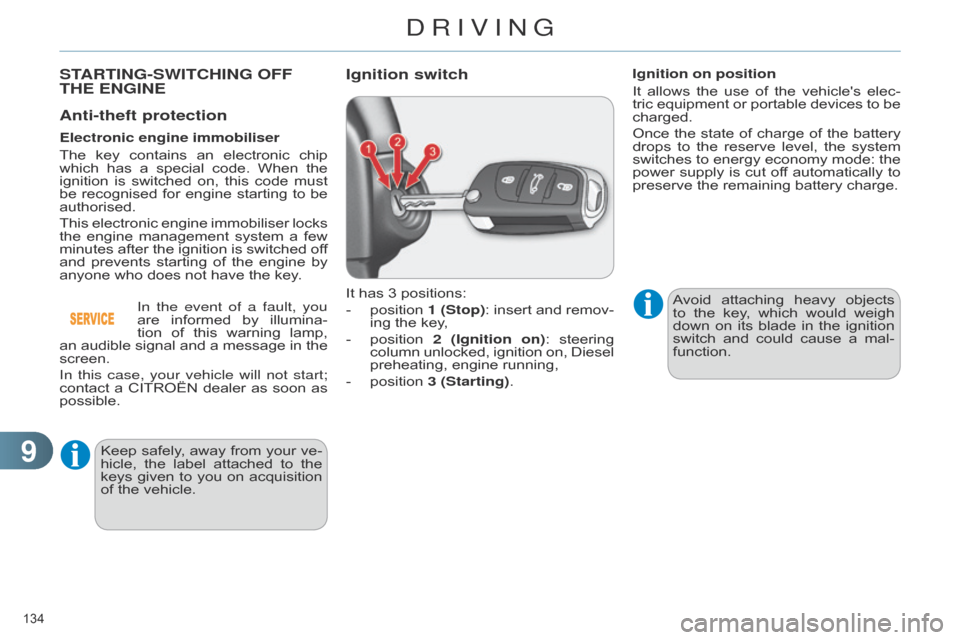
99
134
C4-2_en_Chap09_conduite_ed01-2014
Anti-theft protection
Electronic engine immobiliser
The
key
contains
an
electronic
chip
which
has
a
special
code.
When
the
ignition
is
switched
on,
this
code
must
be
recognised
for
engine
starting
to
be
authorised.
This
electronic
engine
immobiliser
locks
the
engine
management
system
a
few
minutes
after
the
ignition
is
switched
of
f
and
prevents
starting
of
the
engine
by
anyone
who does not have the key.
In the event of a fault, you
are
informed
by
illu
mina-
tion
of
this
warning
lamp,
an
audible
signal
and
a
message
in
the
screen.
In this case, your vehicle will not start;
contact
a
CITROËN
dealer
as
soon
as
possible. It
has 3 positions:
-
position
1
(Stop):
insert
and
remov
-
ing
the key,
-
position
2 (Ignition on)
:
steering
column
unlocked,
ignition
on,
Diesel
preheating,
engine running,
-
position
3 (Starting).Avoid
attaching
heavy
objects
to
the
key
,
which
would
weigh
down
on
its
blade
in
the
ignition
switch
and
could
cause
a
mal
-
function.
Ignition on position
It
allows
the
use
of
the
vehicle's
elec
-
tric
equipment
or
portable
devices
to
be
charged.
Once
the state of charge of the battery drops
to the reserve level, the system
switches
to
energy
economy
mode:
the
power
supply
is
cut
of
f
automatically
to
preserve
the remaining battery charge.
Keep
safely
,
away
from
your
ve
-
hicle,
the
label
attached
to
the
keys
given
to
you
on
acquisition
of
the vehicle.
STARTING-SWITCHING OFF THE ENGINEIgnition switch
DRIVING
Page 137 of 340
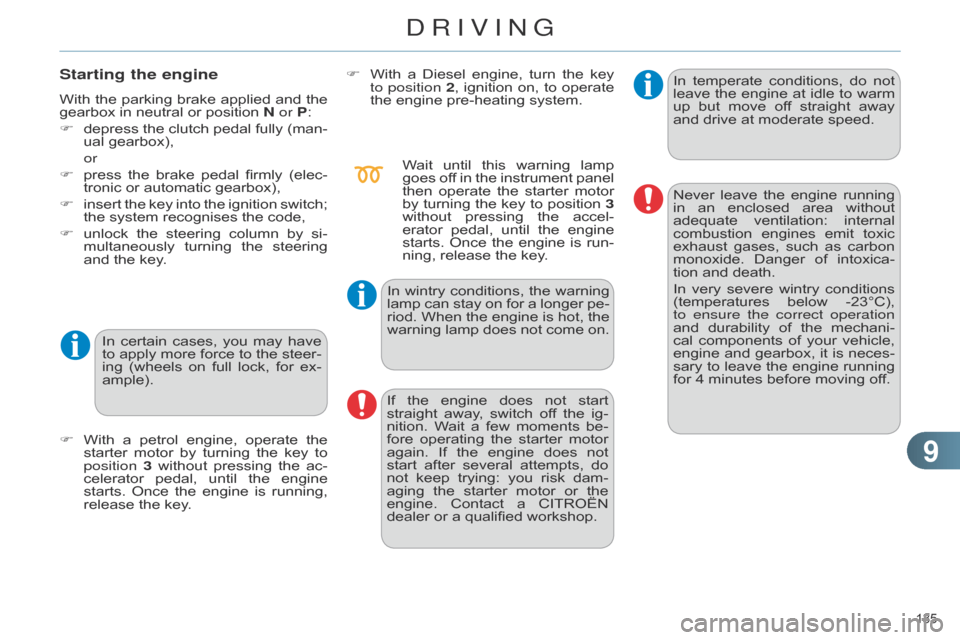
99
135
C4-2_en_Chap09_conduite_ed01-2014
Starting the engine
With the parking brake applied and the gearbox
in neutral or position N or P:
F
depress
the
clutch
pedal
fully
(man
-
ual
gearbox),
or
F
press
the
brake
pedal
firmly
(elec
-
tronic
or automatic gearbox),
F
insert
the
key
into
the
ignition
switch;
the
system recognises the code,
F
unlock
the
steering
column
by
si
-
multaneously
turning
the
steering
and
the key.
In
certain
cases,
you
may
have
to
apply more force to the steer-
ing
(wheels
on
full
lock,
for
ex
-
ample).
F
With
a
petrol
engine,
operate
the
starter
motor
by
turning
the
key
to
position 3
without
pressing
the
ac
-
celerator
pedal,
until
the
engine
starts.
Once
the
engine
is
running,
release
the key. F
With
a
Diesel
engine,
turn
the
key
to position
2, ignition on, to operate the
engine pre-heating system.
Wait
until
this
warning
lamp
goes
of
f
in
the
instrument
panel
then
operate
the
starter
motor
by
turning
the
key
to
position 3
without
pressing
the
accel
-
erator
pedal,
until
the
engine
starts.
Once
the
engine
is
run
-
ning,
release the key.
In
wintry
conditions,
the
warning
lamp
can
stay
on
for
a
longer
pe
-
riod.
When
the
engine
is
hot,
the
warning
lamp
does
not
come
on.
If
the
engine
does
not
start
straight
away
,
switch
of
f
the
ig
-
nition.
W
ait
a
few
moments
be
-
fore
operating
the
starter
motor
again.
If
the
engine
does
not
start
after
several
attempts,
do
not
keep
trying:
you
risk
dam
-
aging
the
starter
motor
or
the
engine.
Contact
a
CITROËN
dealer
or a qualified workshop.In
temperate
conditions,
do
not
leave
the engine at idle to warm up
but move of f straight away
and
drive at moderate speed.
Never
leave
the
engine
running
in
an
enclosed
area
without
adequate
ventilation:
internal
combustion
engines
emit
toxic
exhaust
gases,
such
as
carbon
monoxide.
Danger
of
intoxica
-
tion
and death.
In
very
severe
wintry
conditions
(temperatures
below
-23°C),
to ensure the correct operation
and
durability
of
the
mechani
-
cal
components
of
your
vehicle,
engine
and
gearbox,
it
is
neces
-
sary
to
leave
the
engine
running
for
4 minutes before moving off.
DRIVING
Page 138 of 340

99
136
C4-2_en_Chap09_conduite_ed01-2014
Key left in the "Ignition on"
position
On
opening
the
driver's
door
,
an
alert
message
is
displayed,
ac
-
companied
by
an
audible
signal,
to
remind
you
that
the
key
is
still
in
the
ignition
switch
at
posi
-
tion
1 (Stop).
If
the
key
has
been
left
in
the
igni
-
tion switch at position 2 (Ignition
on),
the
ignition
will
be
switched
of
f automatically after one hour.
To
switch
the
ignition
back
on,
turn
the
key
to
position
1 (Stop)
,
then
back
to
position
2 (Ignition
on)
.Switching off the engine
F Stop the vehicle.
F
With
the
engine
running
at
idle,
turn
the
key to position 1.
F
Remove
the
key
from
the
ignition
switch.
F
T
o
lock
the
steering
column,
turn
the
steering
until it locks. Energy economy mode
After
switching of f the engine (posi -
tion 1-Stop ), for a maximum of 30 min -
utes you can still use functions such
as
the
audio
and
telematic
system,
the
wipers,
dipped
beam
headlamps,
cour
-
tesy
lamps, ...
For
more
information,
refer
to
the
"Practical
information"
sec
-
tion,
under
"Energy
economy
mode".
T
o
facilitate
unlocking
of
the
steer
-
ing
column,
it
is
recommended that
the
wheels
be
returned
to the
straight
ahead
position
before switching
off the engine.
F
Check
that
the
parking
brake
is
cor
-
rectly
applied,
particularly
on
sloping ground.Never
switch
of
f
the
ignition
be
-
fore
the
vehicle
is
at
a
complete
stop.
With
the
engine
of
f,
the
braking
and
steering
assistance
systems
are
also
cut
of
f:
risk
of
loss
of control of the vehicle.
When you leave the vehicle,
keep
the
key
with
you
and
lock
the
vehicle.
DRIVING
Page 139 of 340
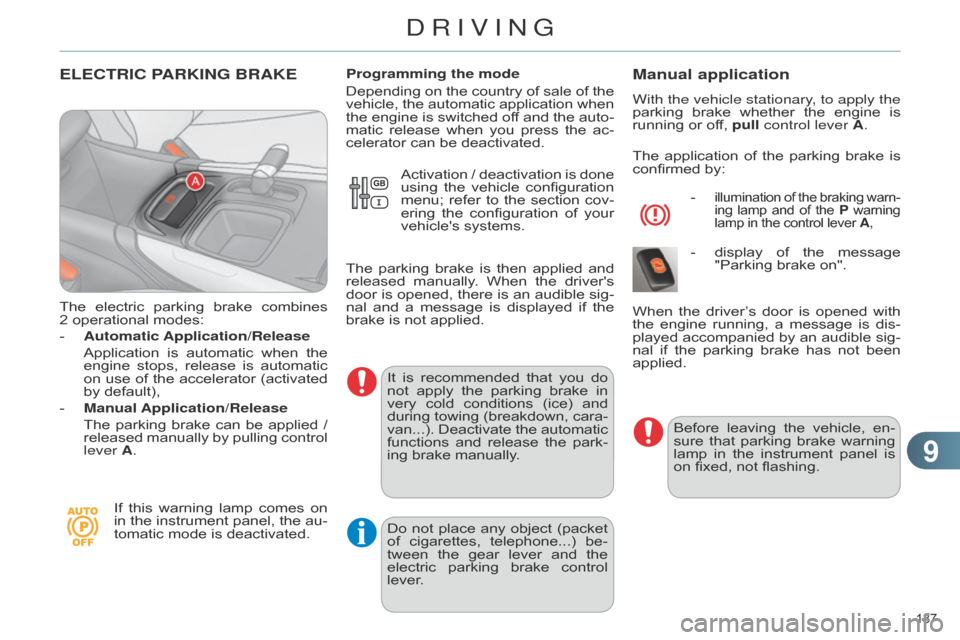
99
137
C4-2_en_Chap09_conduite_ed01-2014
ELECTRIC PARKING BRAKE
The electric parking brake combines 2 operational
modes:
-
Automatic Application/Release
Application
is
automatic
when
the
engine
stops,
release
is
automatic
on
use
of
the
accelerator
(activated
by
default),
-
Manual Application/Release
The
parking
brake
can
be
applied
/
released
manually
by
pullin
g
control
lever
A.
If
this
warning
lamp
comes
on
in
the
instrument
panel,
the
au
-
tomatic
mode is deactivated.Programming the mode
Depending
on
the
country
of
sale
of
the
vehicle,
the
automatic
application
when
the
engine
is
switched
of
f
and
the
auto
-
matic
release
when
you
press
the
ac
-
celerator can be deactivated.
It
is
recommended
that
you
do
not
apply
the
parking
brake
in
very
cold
conditions
(ice)
and
during
towing
(breakdown,
cara
-
van...).
Deactivate
the
automatic
functions
and
release
the
park
-
ing
brake manually.
Manual application
With the vehicle stationary, to apply the
parking brake whether the engine is
running
or off, pull control lever A.
The
application
of
the
parking
brake
is
confirmed
by:
-
illumination of the braking warn -
ing lamp and of the P warning lamp
in the control lever A,
- display of the message "Parking
brake on".
Before
leaving
the
vehicle,
en
-
sure
that
parking
brake
warning
lamp
in
the
instrument
panel
is
on
fixed, not flashing.
When
the
driver
’s
door
is
opened
with
the
engine
running,
a
message
is
dis
-
played
accompanied
by
an
audible
sig
-
nal
if
the
parking
brake
has
not
been
applied.
Activation
/
deactivation
is
done
using
the
vehicle
configuration
menu;
refer
to
the
section
cov
-
ering
the
configuration
of
your
vehicle's
systems.
The
parking
brake
is
then
applied
and
released
manually
.
When
the
driver's
door
is
opened,
there
is
an
audible
sig
-
nal
and
a
message
is
displayed
if
the
brake
is
not
applied.
Do
not
place
any
object
(packet
of
cigarettes,
telephone...)
be
-
tween
the
gear
lever
and
the
electric
parking
brake
control
lever
.
DRIVING
Page 140 of 340

99
138
C4-2_en_Chap09_conduite_ed01-2014
Manual release
With the ignition on or the engine run -
ning, to release the parking brake,
press
on the brake pedal or the accel-
erator, pull then release control A.
The
full
application
of
the
parking
brake
is
confirmed by:
-
the
braking
warning
lamp and
the
P warning
lamp
in the control lever
A
going
of
f,
-
display
of
the
message
"Parking
brake off".
If you pull control lever A with-
out
pressing
the
brake
pedal,
the
parking
brake
will
not
be
released
and
a
warning
lamp
will
come
on
in
the
instrument
panel.
Maximum application
If necessary, you can make a maxi -
mum application of the parking brake.
This
is
obtained
by
means
of
a
long
pull
on the control lever A, until you see
the
message
"Parking
brake
on
maxi
-
mum"
and a beep is heard.
Maximum application is essential:
-
in
the
case
of
a
vehicle
towing
a
caravan
or
a
trailer
,
if
the
automatic
functions
are
activated
but
you
are
applying
the
parking
brake
manu
-
ally,
-
when
the
gradient
you
are
parked
on
may
vary
(e.g.
on
a
ferry
,
on
a
lorry
, during towing),
In
the
case
of
towing,
a
loaded
vehicle
or
parking
on
a
gradient,
make
a
maxi
-
mum
application
of
the
parking
brake
then
turn
the
front
wheels
towards
the
pavement
and
engage
a
gear
when
you
park.
After
a
maximum
application,
the
re
-
lease
time will be longer.
Automatic application,
engine off
- illumination of the braking warn -
ing lamp and of the P warning lamp
in the control lever A,
- display of the message "Parking
brake on".
Before
leaving
the
vehicle,
en
-
sure
that
parking
brake
warning
lamp
in
the
instrument
panel
is
on
fixed (not flashing).
Never
leave
a
child
alone
inside
the
vehicle
with
the
ignition
on,
as
they
could
release
the
park
-
ing
brake.
In
the
case
of
towing,
a
loaded
vehicle
or
parking
on
a
gradient,
turn
the
front
wheels
towards
the
pavement
and
engage
a
gear
when
you park.
The
application
of
the
parking
brake
is
confirmed
by:
With
the
vehicle
stationary
,
the
parking
brake
is
automatically applied when
the engine is switched off.
DRIVING
Page 141 of 340

99
139
C4-2_en_Chap09_conduite_ed01-2014
Automatic release
The electric parking brake releases au-
tomatically and progressively when
you
press the accelerator:
F
Manual gearbox:
press
down
fully
on
the
clutch
pedal,
engage
first
gear
or
reverse,
press
on
the
accel
-
erator
pedal and move off.
F
Electronic gearbox
:
select
posi
-
tion
A
, M or R then press on the ac-
celerator
pedal.
Full
release
of
the
parking
brake
is
con
-
firmed
by:-
the
braking
warning
lamp and
the
P warning
lamp
in the control lever
A
going
of
f,
-
display
of
the
message
"Parking
brake off".
When
stationary
,
with
the
engine
running,
do
not
press
the
ac
-
celerator
pedal
unnecessarily
,
as
you
may
release
the
parking
brake.
Immobilising the vehicle,
engine running
- illumination of the braking warning
lamp and the P warn
-
ing
lamp
in
the
control
lever
A,
- display of the message "Parking
brake on".
Before
leaving
the
vehicle,
en
-
sure
that
parking
brake
warning
lamp
in
the
instrument
panel
is
on
fixed, not flashing.
Particular situations
In certain situations (e.g. starting the engine),
the parking brake can auto -
matically
alter
its
force.
This
is
normal
operation.
T
o
advance
your
vehicle
a
few
centi
-
metres
without
starting
the
engine,
but
with
the
ignition
on,
press
on
the
brake
pedal
and
release
the
parking
brake
by pulling
then releasing the control
lever
A
.
The
full
release
of
the
park
-
ing
brake
is
confirmed
by
the
warning
lamps
in
the
control
lever
A
and
in
the
instrument
panel
going
of
f
and
display
of
the message "Parking brake off".
When
the
driver
’s
door
is
opened,
a
message
is
displayed
accompanied
by
an
audible
signal,
if
the
parking
brake
has
not
been
applied.
The
application
of
the
parking
brake
is
confirmed
by:
With
the
engine
running
and
the
vehicle
stationary
,
in
order
to
immobilise
the
vehicle it is essential to
manually ap-
ply
the
parking
brake
by
pulling
control
lever A.
DRIVING
Page 144 of 340
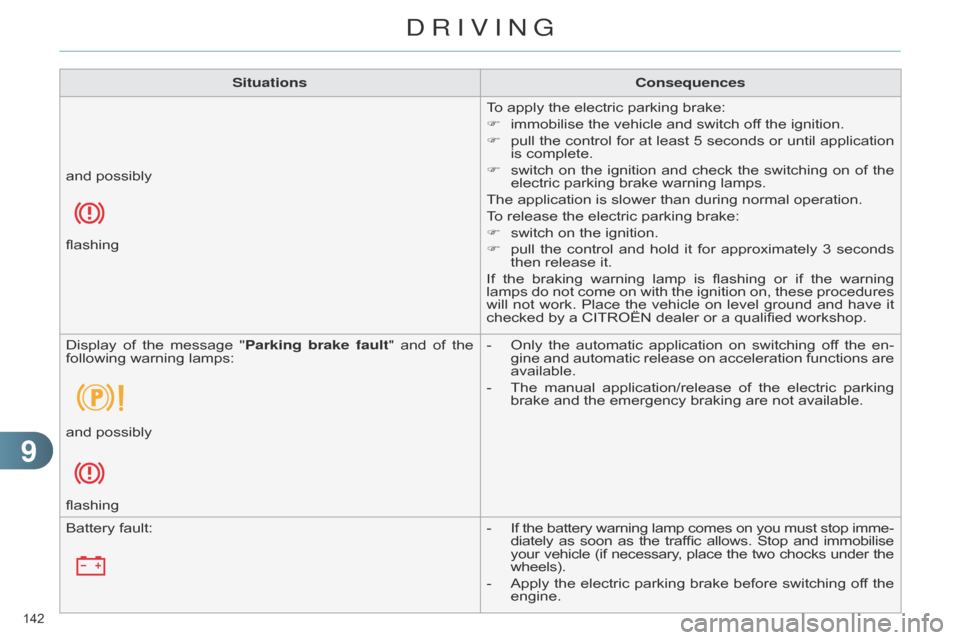
99
142
C4-2_en_Chap09_conduite_ed01-2014
SituationsConsequences
To apply the electric parking brake:
F
immobilise
the vehicle and switch off the ignition.
F
pull
the
control
for
at
least
5
seconds
or
until
application
is
complete.
F
switch
on
the
ignition
and
check
the
switching
on
of
the
electric
parking brake warning lamps.
The
application is slower than during normal operation.
To
release the electric parking brake:
F
switch
on the ignition.
F
pull
the
control
and
hold
it
for
approximately
3
seconds
then
release it.
If
the
braking
warning
lamp
is
flashing
or
if
the
warning
lamps
do
not
come
on
with
the
ignition
on,
these
procedures
will
not
work.
Place
the
vehicle
on
level
ground
and
have
it
checked
by a CITROËN dealer or a qualified workshop.
and
possibly
flashing
Display
of
the
message
"
Parking brake fault"
and
of
the
following
warning
lamps: -
Only
the
automatic
application
on
switching
of
f
the
en
-
gine
and
automatic
release
on
acceleration
functions
are
available.
-
The
manual
application/release
of
the
electric
parking
brake
and the emergency braking are not available.
and
possibly
flashing
Battery
fault: -
If
the
battery
warning
lamp
comes
on
you
must
stop
imme
-
diately
as
soon
as
the
traffic
allows.
Stop
and
immobilise your
vehicle
(if
necessary
,
place
the
two
chocks
under
the wheels).
-
Apply
the
electric
parking
brake
before
switching
of
f
the
engine.
DRIVING
Page 145 of 340
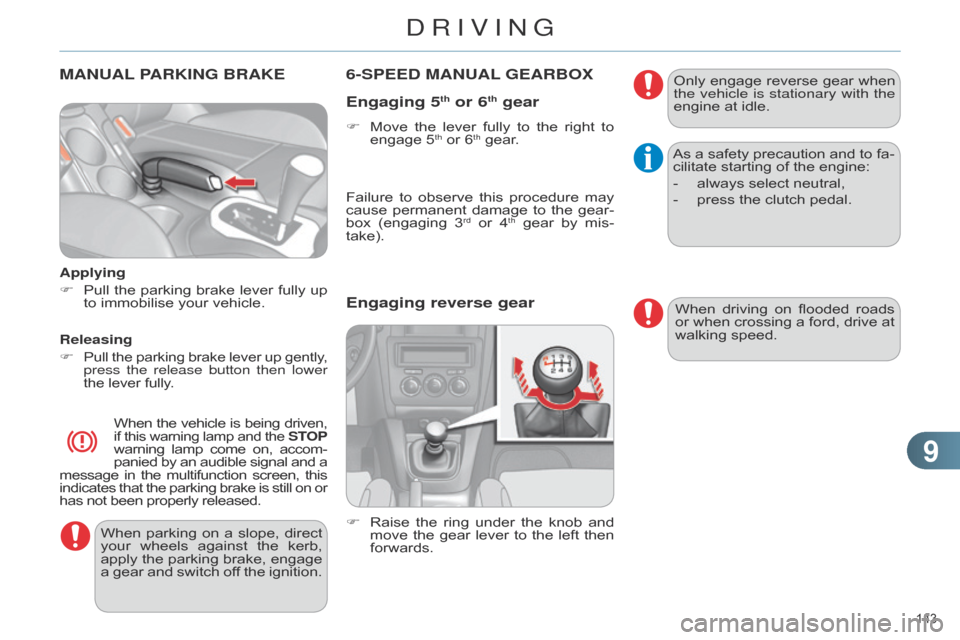
99
143
C4-2_en_Chap09_conduite_ed01-2014
MANUAL PARKING BRAKE
Applying
F
Pull
the
parking
brake
lever
fully
up
to
immobilise your vehicle.
Releasing
F
Pull the parking brake lever up gently , press the release button then lower
the
lever fully.
When the vehicle is being driven, if this warning lamp and the ST OP warning lamp come on, accom -
panied by an audible signal and a message
in
the
multifunction
screen,
this indicates
that
the
parking
brake
is
still
on
or has
not
been properly released.
When parking on a slope, direct your
wheels against the kerb,
apply
the
parking
brake,
engage
a
gear
and
switch
of
f
the
ignition.
6-SPEED MANUAL GEARBOX
Engaging 5th or 6th gear
F Move the lever fully to the right to engage
5th or 6th gear. Only
engage
reverse
gear
when
the
vehicle is stationary with the
engine at idle.
As a safety precaution and to fa -
cilitate
starting of the engine:
-
always
select neutral,
-
press
the clutch pedal.
Engaging reverse gear
F Raise the ring under the knob and move
the gear lever to the left then
forwards.
Failure
to
observe
this
procedure
may
cause
permanent
damage
to
the
gear
-
box
(engaging
3rd or
4th gear by mis -
take).
When
driving
on
flooded
roads
or
when
crossing
a
ford,
drive
at
walking
speed.
DRIVING